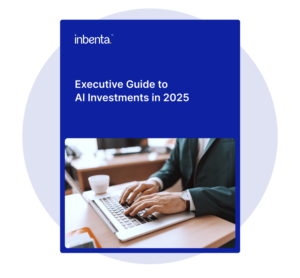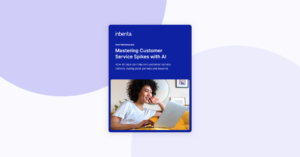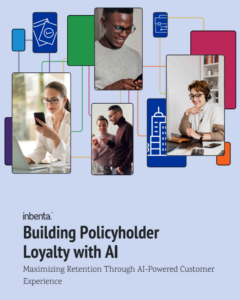Generative AI has caught the attention of consumers and businesses the world over. Many see Generative AI as a revolutionary new way to create novel content, speed up content development timelines, and act as a sorting tool capable of surfacing answers instantly.
According to a recent report, more than 80% of Fortune 500 companies had teams actively using ChatGPT, a Generative AI platform.[1]
Generative AI has also been the subject of increasing media and regulatory scrutiny. As with any new technology, especially one as powerful as Generative AI, some skepticism is understandable. But for many tech-forward companies, Generative AI initiatives are moving ahead regardless.
To help companies navigate the topic of Generative AI and come up with a thoughtful point of view, Inbenta developed the following article to educate readers on Generative AI, the use cases it can address, and how it can be used responsibly.
What is Generative AI?
Generative AI is simply a subset of artificial intelligence that focuses on generating new content. This can take many forms, such as text, images, or audio. The hype around Generative AI stems from the fact that the content is original and can resemble the quality of human-generated output. Generative AI has been able to achieve this result because of its ability to continually train itself on vast amounts of unstructured data without the need for human supervision.
Generative AI Use Cases
While much of the conversation on Generative AI is around ChatGPT, a Large Language Model, there are many different types of Generative AI being used today. These include:
- Text generators in the form of coding solutions (OpenAI Codex, Copilot, Studio Bot) as well as Language Language Models (ChatGPT, Google Bard and others) that can create written content, including marketing and promotional materials, summaries, essays, and more.
- Image and video generators that can create synthetic images (DALL-E, Let’s Enhance, Midjourney), 3D images, or video content (Pictory, Synthesia or DeepBrain AI) from simple prompts.
- Auditory generators that are able to create songs (Amper Music, AIVA, Soundful) or mimic an individual’s speech from a short audio recording.
How Does a Large Language Model Work?
In the realm of Generative AI, of significant interest to Inbenta’s customers are Large Language Models (LLMs), mainly driven by the introduction of ChatGPT.
LLMs uses a series of algorithms to recognize, summarize, translate, predict and generate text and other forms of content. In order to do so, it uses knowledge gained from massive datasets that have been fed into the system, allowing the model to create novel content.
Users provide the LLM with a ‘prompt’ or inquiry to generate responses. Ideally, the more parameters used in an LLM prompt, the more accurate the responses will be.
Benefits of Using LLMs
Customer-Facing Benefits of LLMs
If harnessed correctly, the generative ability of LLMs to create and organize content instantaneously has massive potential. The upside includes cutting content development timelines and helping organizations scale their operations to respond to more customers faster.
In a customer experience setting, automatically generating content can help:
- Answer customer questions in real time with no wait times in a frictionless way;
- Generate unique and original answers, bringing the customer closer to what an interaction with a real agent might be;
- Personalize interactions and tailor answers based on user data and more, by analyzing and understanding the nuances of human language and analyzing the user’s profile.
Operational Benefits of LLMs
Implementing LLMs into customer experience workflows also feature operational benefits. Included in these operational benefits, it is possible for LLMs to:
- Cut down on content development timeframes, and create content at the pace your customer’s expectations;
- Reduce repetitive tasks in favor of automation;
- Serve as a productivity multiplier, empowering staff and helping them focus on more complex tasks.
Risks of LLMs
LLMs have also come under heavy scrutiny for their accuracy as well as data privacy and copyright concerns.
Regulators in the U.S. and abroad have expressed concerns related to Generative AI’s potential harm to consumers, especially in regulated industries. For example, if a bank or fiduciary were to provide misleading information via a LLM chatbot, lawsuits and penalties would surely follow.
Enterprises looking to integrate LLMs, especially into a customer-facing setting, need to be aware of the risks and look for ways to ensure compliance.
These risks include:
- Hallucinations where an LLM will respond with an inaccurate or nonsensical response;
- Data privacy issues that arise when dealing any software that doesn’t properly notify and ask users for their consent to use their data;
- Copyright is another risk if it is found that the LLM is using copyrighted work illegally.
Without the proper checks in place, these risks could be difficult to navigate since LLMs are a black box, making it impossible to understand how or where the LLM came up with a certain response. If enterprises had more insight into instances of hallucination or copyright for example, they could tailor their use accordingly. That is why adding a layer of review and compliance will be so important when considering using an LLM in an enterprise setting.
LLMs Coupled With Conversational AI
A separate and distinct language-based AI from LLMs is Conversational AI, which has been the standard language technology used in customer experience settings (including chatbots, search engines, and other tools) for some time. Conversational AI uses natural language processing (NLP) alongside a large lexicon (a dictionary with words and their semantic relationships) to power human-like conversations between chatbots and humans.
While powerful and effective at facilitating conversations, Conversational AI is limited to its own knowledge and pre-programmed responses. (In some use cases, Conversational AI might be preferred, particularly for those worried about the “hallucination rate” or compliance risk of LLMs.)
Coupling Conversational AI with LLMs, however, holds great potential. By combining the creativity of Generative AI with the conversational prowess of Conversational AI, businesses can supercharge content creation and offer personalized and engaging interactions using unique answers that closely mimic human conversations.
Furthermore, the synergy between these AI technologies can lead to more intelligent and context-aware interactions.
Inbenta’s LLM Integration
To help Inbenta’s customers leverage the power of LLMs while mitigating some of the compliance risks, Inbenta launched an expansive Generative AI integration.
The integration allows companies to use any LLM of their choice to develop and organize their content instantaneously, with minimal effort, and in a manner that supports the opportunity for oversight and increased compliance.
As a part of the integration, companies will be able to seamlessly add Open AI, Google, Claude AI or other leading Generative AI platforms into their customer experience workflows and control how, where, and when these platforms are used.
By adding Generative AI, Inbenta aims to cut a company’s content development timeline by well over half, supercharging their ability to quickly develop customer service responses, chatbot scripts, helpful content pieces and more.
Importantly, by providing choice and the ability to control the review and delivery of AI generated content, Inbenta is helping companies deploy Generative AI in a safer and more responsible manner, allowing companies to add layers of human oversight and review of AI-generated content.
For organizations concerned with the potential risks of Generative AI (particularly those within regulated industries, complex product lines, or that have specific terms and conditions), Inbenta’s industry leading Conversational AI capability should not be overlooked.
In most cases, Inbenta’s Conversational AI can accurately resolve +90% of customer inquiries, regardless of industry. For customer inquiries outside of Conversational AI’s ability, Inbenta also offers a Messenger solution that helps customer service representatives quickly triage, escalate, and resolve requests.
Inbenta’s Generative AI integration highlights include:
- Choose your Generative AI provider. Inbenta allows you to choose your preferred leading Generative AI tool. Easily integrate OpenAI, Google or any other solution into Inbenta’s customer experience platform.
- Use Generative AI safely by adding a layer of compliance. Minimize risk by choosing where, how and when you want to use Generative AI without compromising on customer service quality.
- Enable human oversight. Access and review AI generated content before it goes live.
- Combine the benefits of Conversational AI and Generative AI. Improve the accuracy of AI-generated content by tapping into Inbenta’s NLP’s engine.
- Plug Generative AI into different customer experience workflows. Pick where you want to leverage Generative AI, whether in customer service communications, chatbot scripts, to create FAQs and more.
Interested in learning about the benefits of Generative AI and Conversational AI? And which might be right for you? Schedule a demo and discover its full potential here.
Source – [1]CNBC, “OpenAI launches ChatGPT Enterprise, the company’s biggest announcement since ChatGPT’s debut. “August 28,2023. URL Reference: https://www.cnbc.com/2023/08/28/openai-chatgpt-enterprise-launches.html










